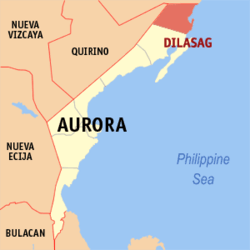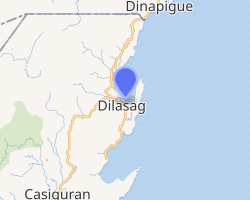Dilasag, Aurora
Dilasag, officially the Municipality of Dilasag (Tagalog: Bayan ng Dilasag; Ilocano: Ili ti Dilasag), is a 3rd class municipality in the province of Aurora, Philippines. According to the 2015 census, it has a population of 15,835 people.[3]
Dilasag | |
|---|---|
| Municipality of Dilasag | |
| Nickname(s): Gateway to the Madre Valley | |
 Map of Aurora with Dilasag highlighted | |
OpenStreetMap 
| |
.svg.png) Dilasag Location within the Philippines | |
| Coordinates: 16°24′N 122°13′E | |
| Country | |
| Region | Central Luzon (Region III) |
| Province | Aurora |
| District | Lone District |
| Founded | 1959 |
| Barangays | 11 (see Barangays) |
| Government | |
| • Type | Sangguniang Bayan |
| • Mayor | Joe P. Gorospe |
| • Vice Mayor | Romner A. Agustin |
| • Congressman | Rommel Rico T. Angara |
| • Electorate | 10,603 voters (2019) |
| Area | |
| • Total | 306.25 km2 (118.24 sq mi) |
| Population (2015 census)[3] | |
| • Total | 15,835 |
| • Density | 52/km2 (130/sq mi) |
| • Households | 3,860 |
| Economy | |
| • Income class | 3rd municipal income class |
| • Poverty incidence | 12.39% (2015)[4] |
| • Revenue (₱) | 86,119,077.17 (2016) |
| Time zone | UTC+8 (PST) |
| ZIP code | 3205 |
| PSGC | |
| IDD : area code | +63 (0)42 |
| Climate type | tropical rainforest climate |
| Native languages | Kasiguranin Ilocano Tagalog |
| Website | www |
History
The name "Dilasag" was divided into two syllables. The prefix "Di" in the Native Language means "abundance", added to the word "lasag" which means "meat". The coined word "Dilasag", however, does not only mean abundance of meat in the place but also refers to extreme bounty or over sufficient supply of forest products, marine or other aquatic products and minerals, including the Yamashita treasure believed to be buried along its coastal areas.
In the early 1924, a group of settlers from the Province of Tarlac arrived to Casiguran, which is now the adjacent Town of Dilasag. Finding the natives unfriendly to them, these new settlers ventured to move along the coastline going north and settled finally to what is now called Dilasag. The place is considered habitable, because the Native Dumagats in the place were friendly. Later, more families came making the place a community. This community was soon recognized by the Local Chief Executive of Casiguran, formerly a municipality of the Province of Quezon. It was declared a sitio of barangay Culat and eventually a barrio of Casiguran in consideration of its rapid progress and development. In 1959, Congressman Enverga introduced House Bill No. 2863 in the House of Representatives, resulting to the approval of Republic Act No. 2452 on June 21, 1959, making Dilasag a Municipal District, which was separated from Casiguran.[5]
Geography
According to the Philippine Statistics Authority, the municipality has a land area of 306.25 square kilometres (118.24 sq mi) [2] constituting 9.73% of the 3,147.32-square-kilometre- (1,215.19 sq mi) total area of Aurora.
Barangays
Dilasag is politically subdivided into 11 barangays.[6]
| PSGC | Barangay | Population | ±% p.a. | |||
|---|---|---|---|---|---|---|
| 2015[3] | 2010[7] | |||||
| 037703001 | Diagyan | 15.3% | 2,418 | 2,537 | −0.91% | |
| 037703002 | Dicabasan | 4.6% | 734 | 677 | 1.55% | |
| 037703003 | Dilaguidi | 5.8% | 915 | 1,015 | −1.96% | |
| 037703004 | Dimaseset | 9.0% | 1,420 | 1,408 | 0.16% | |
| 037703005 | Diniog | 15.7% | 2,485 | 2,331 | 1.23% | |
| 037703011 | Esperanza | 8.0% | 1,266 | 1,241 | 0.38% | |
| 037703006 | Lawang | 3.2% | 511 | 379 | 5.85% | |
| 037703007 | Maligaya (Poblacion) | 11.8% | 1,869 | 1,801 | 0.71% | |
| 037703008 | Manggitahan | 11.0% | 1,742 | 1,760 | −0.20% | |
| 037703009 | Masagana (Poblacion) | 11.6% | 1,841 | 1,822 | 0.20% | |
| 037703010 | Ura | 4.0% | 634 | 712 | −2.19% | |
| Total | 15,835 | 15,683 | 0.18% | |||
Climate
| Climate data for Dilasag, Aurora | |||||||||||||
|---|---|---|---|---|---|---|---|---|---|---|---|---|---|
| Month | Jan | Feb | Mar | Apr | May | Jun | Jul | Aug | Sep | Oct | Nov | Dec | Year |
| Average high °C (°F) | 25 (77) |
26 (79) |
27 (81) |
30 (86) |
31 (88) |
30 (86) |
30 (86) |
30 (86) |
29 (84) |
28 (82) |
27 (81) |
25 (77) |
28 (83) |
| Average low °C (°F) | 21 (70) |
21 (70) |
22 (72) |
23 (73) |
24 (75) |
24 (75) |
24 (75) |
24 (75) |
24 (75) |
23 (73) |
23 (73) |
22 (72) |
23 (73) |
| Average precipitation mm (inches) | 96 (3.8) |
77 (3.0) |
66 (2.6) |
59 (2.3) |
119 (4.7) |
133 (5.2) |
159 (6.3) |
143 (5.6) |
152 (6.0) |
243 (9.6) |
218 (8.6) |
200 (7.9) |
1,665 (65.6) |
| Average rainy days | 17.7 | 14.7 | 14.9 | 13.7 | 19.9 | 20.6 | 24.2 | 24.0 | 23.5 | 21.8 | 21.5 | 21.4 | 237.9 |
| Source: Meteoblue (modeled/calculated data, not measured locally)[8] | |||||||||||||
Demographics
|
| ||||||||||||||||||||||||||||||||||||
| Source: Philippine Statistics Authority[3][7][9][10] | |||||||||||||||||||||||||||||||||||||
In the 2015 census, Dilasag had a population of 15,835.[3] The population density was 52 inhabitants per square kilometre (130/sq mi).
Tourist spots
Coastal areas of Dilasag feature white sand beaches and fresh sea foods. With its mountainous terrain, Dilasag also provides an ideal venue for trekking and mountain-climbing.
- Canawer Beach
- Parang Hills
- Diniog Beach
- Mangrove Forest Park
- Singep Falls
The municipality is also home to the Amro River Protected Landscape.
References
- "Municipality". Quezon City, Philippines: Department of the Interior and Local Government. Retrieved 31 May 2013.
- "Province: Aurora". PSGC Interactive. Quezon City, Philippines: Philippine Statistics Authority. Retrieved 12 November 2016.
- Census of Population (2015). "Region III (Central Luzon)". Total Population by Province, City, Municipality and Barangay. PSA. Retrieved 20 June 2016.
- "PSA releases the 2015 Municipal and City Level Poverty Estimates". Quezon City, Philippines. Retrieved 12 October 2019.
- "Republic Act No. 4785; An Act Converting the Municipal District of Dilasag in the Subprovince of Aurora, Province of Quezon, into a Municipality". The Corpus Juris. 18 June 1966. Archived from the original on 6 November 2016. Retrieved 6 November 2016.
- "Municipal: Dilasag, Aurora". PSGC Interactive. Quezon City, Philippines: Philippine Statistics Authority. Retrieved 8 January 2016.
- Census of Population and Housing (2010). "Region III (Central Luzon)". Total Population by Province, City, Municipality and Barangay. NSO. Retrieved 29 June 2016.
- "Dilasag, Aurora: Average Temperatures and Rainfall". Meteoblue. Retrieved 27 December 2018.
- Censuses of Population (1903–2007). "Region III (Central Luzon)". Table 1. Population Enumerated in Various Censuses by Province/Highly Urbanized City: 1903 to 2007. NSO.
- "Province of Aurora". Municipality Population Data. Local Water Utilities Administration Research Division. Retrieved 17 December 2016.